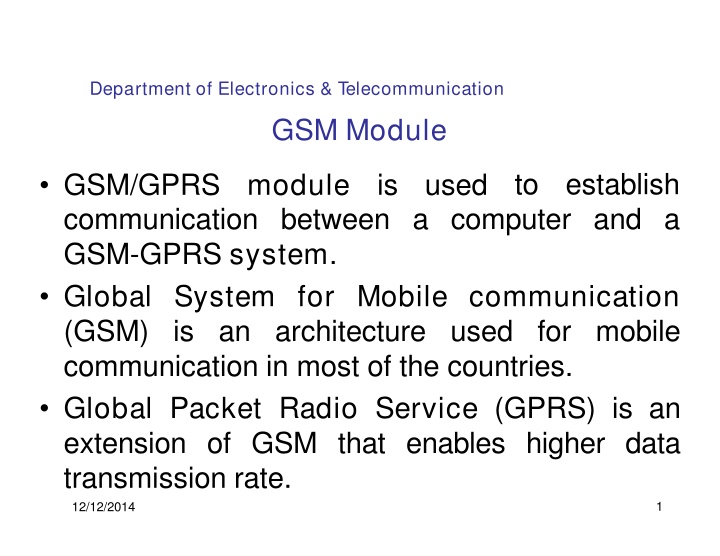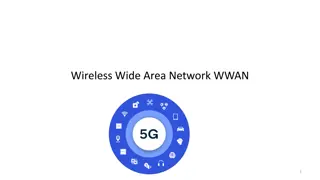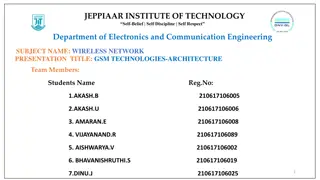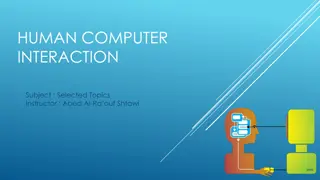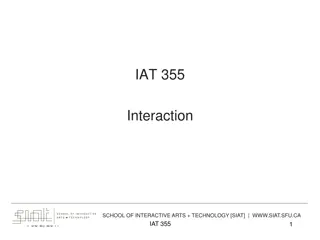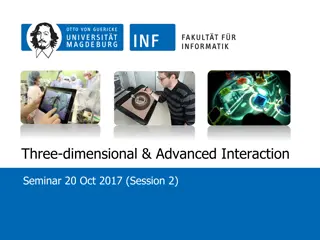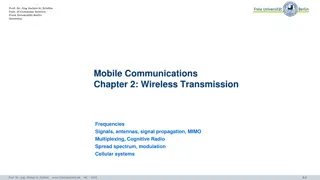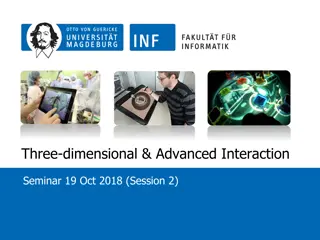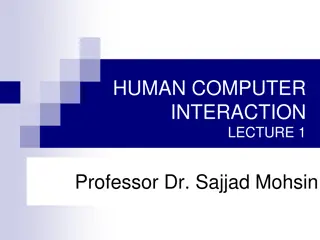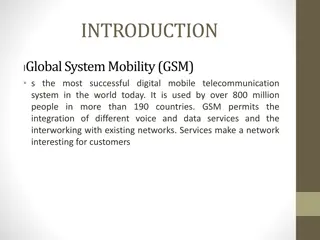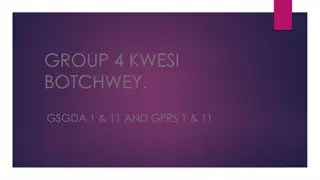Establishing GSM/GPRS Communication for Computer Interaction
Global System for Mobile Communication (GSM) and Global Packet Radio Service (GPRS) are crucial for mobile communication systems. Learn about GSM modules, AT commands, GSM mobile vs. modules, and typical connection applications in this field.
Download Presentation

Please find below an Image/Link to download the presentation.
The content on the website is provided AS IS for your information and personal use only. It may not be sold, licensed, or shared on other websites without obtaining consent from the author.If you encounter any issues during the download, it is possible that the publisher has removed the file from their server.
You are allowed to download the files provided on this website for personal or commercial use, subject to the condition that they are used lawfully. All files are the property of their respective owners.
The content on the website is provided AS IS for your information and personal use only. It may not be sold, licensed, or shared on other websites without obtaining consent from the author.
E N D
Presentation Transcript
Department of Electronics & Telecommunication GSM Module to establish GSM/GPRS communication between a computer and a GSM-GPRS system. Global System for Mobile communication (GSM) is an architecture used for mobile communication in most of the countries. Global Packet Radio Service (GPRS) is an extension of GSM that enables higher data transmission rate. 12/12/2014 module is used 1
GSM Module 3 12/12/2014 Shridhar S. Dudam
GSM Mobile Vs GSM Module A GSM mobile is a complete system in itself with embedded processors that are dedicated to provide an interface between the user and the mobile network. The AT commands are processors of the mobile termination terminal equipment. The mobile handset can also be equipped with a USB interface to connect with a computer, but it may or may not support AT computer or an external processor/controller. served between the the and commands from the
Department of Electronics & Telecommunication GSM Mobile Vs GSM Module The GSM/GPRS module, on the other hand, always needs a computer or external processor/controller to receiveAT commands from. GSM/GPRS module itself does not provide any interface between the user and the network, but the computer to which module is connected is the interface between user and network. An advantage that GSM/GPRS modules offer is that they support concatenated SMS which may not be supported in some GSM mobile handsets.
Department of Electronics & Telecommunication GSM/GPRS Typical Connection Applications of GSM/GPRS module The GSM/GPRS module demonstrates commands. They can feature all the functionalities mobile phone through computer like making and receiving calls, SMS, MMS etc. These are mainly computer based SMS and MMS services. the use of AT of a employed for
Department of Electronics & Telecommunication AT Commands AT commands are used to control MODEMs. AT is the abbreviation for Attention. These commands come from Hayes commands that were used by the Hayes smart modems. The Hayes commands started with AT to indicate the attention from the MODEM. The dial up and wireless MODEMs need AT commands to interact with a computer. AT commands with a GSM/GPRS MODEM or 12/12/2014 6
Department of Electronics & Telecommunication AT Commands AT commands with a GSM/GPRS MODEM or mobile phone can be used to access following information and services: Information and configuration pertaining to mobile device or MODEM and SIM card. SMS services. MMS services. Fax services. Data and Voice link over mobile network. 7 12/12/2014
Department of Electronics & Telecommunication Execution of AT Commands 9 12/12/2014
Department of Electronics & Telecommunication AT Commands Syntax Case Sensitivity - The AT commands are generally used in uppercase letters. Single Command - commands have a + in the command name. For example: AT+CGMI<Carriage return> The extended AT 10 12/12/2014 Shridhar S. Dudam
Department of Electronics & Telecommunication AT Commands Syntax Command Line - Multiple AT commands can be sent to MODEM in a single command line. AT+CGMI; +CBS<Carriage return> String in Command Line - Strings in a command line are enclosed in double quotes. AT+CGML= ALL <Carriage return> 12/12/2014 11 Shridhar S. Dudam
Department of Electronics & Telecommunication AT Commands : Response The Information Response and Result Codes, returned by the MODEM, have a carriage return and line feed in the beginning as well as at the end. <CR><LF> OK <CR><LF> <CR><LF> ERROR <CR><LF> <CR><LF> +CBC: 0, 60 <CR><LF> 12 12/12/2014
Department of Electronics & Telecommunication AT Commands : Result Codes OK - Successful Execution of a command ERROR - Execution of a command failed +CMS ERROR - Message service failure, is returned with an error code +CDS - Notify receipt of SMS status report of a new message to computer +CDSI - Notify receipt of SMS status report of a new message and its location in memory to computer +CMT - Notify forwarding of a new SMS to computer +CMTI - Notify receipt of SMS status report of a new message 13
Department of Electronics & Telecommunication AT Commands : For sending SMS 1. First select the text mode for SMS- AT+CMGF = 1 . 2. Send mobile number AT+CMGS =+923005281046 3. Send the text message string ("hello!") 4. Send ASCII code for CTRL+Z i.e., 0x1A to GSM Modem to transmit the message to mobile phone. 5. Every AT command is followed by i.e. carriage return and line feed to the GSM Modem 13 12/12/2014
Department of Electronics & Telecommunication GPS Receiver Module GPS receivers use a constellation of satellites and ground stations to compute position and time almost anywhere on earth. 14 12/12/2014
Department of Electronics & Telecommunication GPS Receiver Module At any given time, there are at least 24 active satellites orbiting over 12,000 miles above earth. The positions of the satellites are constructed in a way that the sky above your location will always contain at most 12 satellites. The primary purpose of the 12 visible satellites is to transmit information back frequency (ranging from 1.1 to 1.5 GHz). With this information and some math, a ground based receiver or GPS module can calculate its position and time. to earth over radio 15 12/12/2014
Department of Electronics & Telecommunication GPS Receiver Block Diagram 16 12/12/2014
Department of Electronics & Telecommunication GPS Receiver Module 17 12/12/2014
Department of Electronics & Telecommunication Calculate position and time. The data sent down to earth from each satellite contains a few different pieces of information that allows your GPS receiver to accurately calculate its position and time. An important piece of equipment on each GPS satellite is an extremely accurate atomic clock. The time on the atomic clock is sent down to earth along with the satellite s orbital position and arrival times at different points in the sky. 18 12/12/2014
Department of Electronics & Telecommunication Calculate position and time. In other words, the GPS module receives a timestamp from each of the visible satellites, along with data on where in the sky each one is located (among other pieces of data). From this information, the GPS receiver now knows the distance to each satellite in view. If the GPS receiver s antenna can see at least 4 satellites, it can accurately calculate its position and time. This is also called a lock or a fix. 19 12/12/2014
Department of Electronics & Telecommunication Message Formats GPS data is displayed in different message formats over a serial interface. There are standard and non-standard (proprietary) message formats. Nearly all GPS receivers output NMEA data. The NMEA standard is formatted in lines of data called sentences. Each sentence contains organized in comma delimited format separated by commas). various bits of data (i.e. data 20 12/12/2014
Department of Electronics & Telecommunication Connecting to Microcontroller Once a GPS module is powered, NMEA data is sent out of a serial transmit pin (TX) at a specific baud (4800 bps) rate, even if there is no lock. 21 12/12/2014
Department of Electronics & Telecommunication NMEA Standard The National Marine Electronics Association (NMEA) has developed standards that describe the interface between various marine electronic equipments. GPS receivers also NMEA Standards. The data given by the GPS receiver includes many information like position (latitude and longitude), altitude, speed, time etc. In its standards, NMEA has specified to send a series of data in a sentence. work on these 22 12/12/2014
Department of Electronics & Telecommunication NMEA Standard All standard devices have a two letter prefix that defines the device for which it is being used, for GPS receivers the prefix is GP. The two letter prefix is then followed by three letters which represent the content of the sentence. Every sentence begins with a $ sign, has about 80 characters and ends up with a carriage return/line feed sequence. Sentences are mostly framed in single lines and the data items in each sentence are separated by 1c2/o 12m /201m 4as. 24
Department of Electronics & Telecommunication $GPGGA - Global Positioning System Fix Data $GPGGA,132453.970,2651.0138,N,07547.7054,E,1, 03,7.1,42.5,M,-42.5,M,,0000*45 Fix taken at 13:24:53970 UTC Latitude 26 deg 51.0138' N Longitude 07 deg 54.7054' E Fix quality: 1 = GPS fix (SPS) Number of satellites being tracked Horizontal dilution of position 24 12/12/2014
Department of Electronics & Telecommunication $GPGGA - Global Positioning System Fix Data $GPGGA,132453.970,2651.0138,N,07547.7054,E,1, 03,7.1,42.5,M,-42.5,M,,0000*45 Altitude, Meters, above mean sea level Height of geoid (mean sea level) above WGS84 Ellipsoid Time in seconds since last DGPS update DGPS station ID number The checksum data, always begins with * 25 12/12/2014
Department of Electronics & Telecommunication GPS Sentences $GPGSV - (Satellites in view) $GPGSV,3,1,12,18,57,291,40,21,56,346,45,26,23,0 43,46,29,57,174,25*71 $GPRMC - Recommended minimum specific GPS/Transit data $GPRMC,132455.970,A,2651.0145,N,07547.7051,E ,0.50,342.76,301010,,,A*64 26 12/12/2014
Department of Electronics & Telecommunication GPS Sentences $GPGSV - (Satellites in view) $GPGSV,3,1,12,18,57,291,40,21,56,346,45,26,23,0 43,46,29,57,174,25*71 $GPRMC - Recommended minimum specific GPS/Transit data $GPRMC,132455.970,A,2651.0145,N,07547.7051,E ,0.50,342.76,301010,,,A*64 27 12/12/2014
Department of Electronics & Telecommunication UART section of LPC 2148: The LPC 2148 contains two UARTs which are compatible with UART IC 16C550 (Industry Standard UART IC). UART0 provides only standard transmit and receive data lines UART1 also provides a full modem control handshake interface along with standard transmit and receive data lines. 28 12/12/2014
Department of Electronics & Telecommunication UART Register Map Name U0RBR (DLAB=0) U0THR (DLAB=0) U0DLL (DLAB=1) U0DLM (DLAB=1) U0IER (DLAB=0) U0IIR U0FCR U0LCR U0LSR U0SCR U0ACR U0FDR U0TER Description Receiver Buffer Register Transmit Holding Register Divisor Latch LSB Divisor Latch MSB Interrupt Enable Register Interrupt ID Register FIFO Control Register Line Control Register Line Status Register Scratch Pad Register Auto-baud Control Reg. Fractional Divider Reg. TX. Enable Reg 29 12/12/2014
Department of Electronics & Telecommunication Interfacing Diagram VC C C 8 C 12 1uF 1uF 1 6 U3 1 3 4 5 C 10 J8 C 1+ C 1- C 2+ C 2- 1 6 VC C 9 2 6 1uF C VS+ VS- 1uF C 11 2 7 1uF 11 15 3 8 TXD T1IN GND 12 14 4 9 T1OUT R 1IN R 2IN T2OUT R XD R 1OUT 13 10 8 5 T2IN R 2OUT 9 7 D C onnector9 M AX232N 30 12/12/2014
